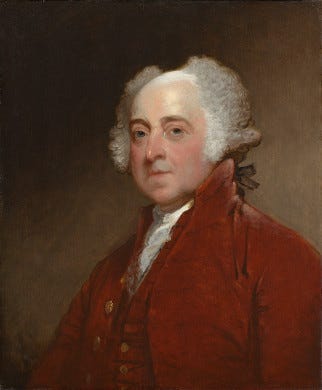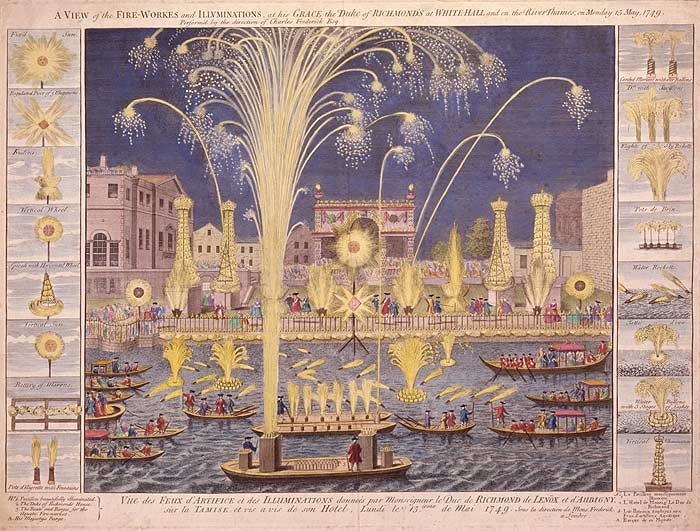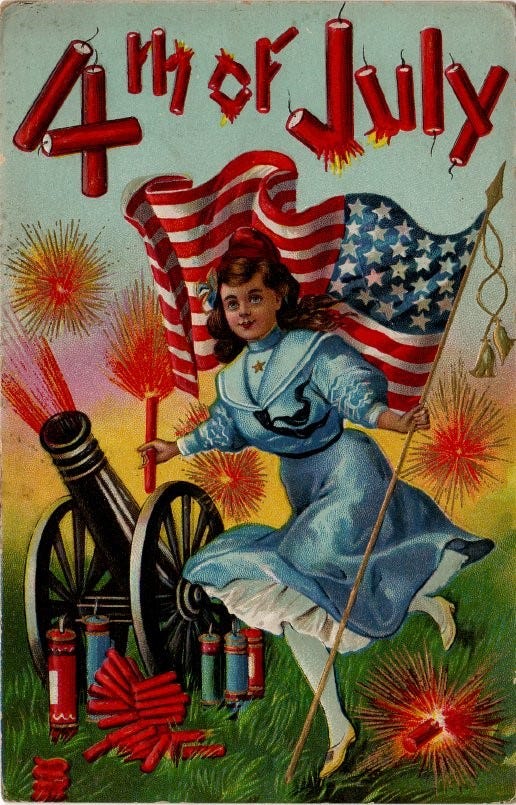Special What's It on Monday -The 4th of July is here!! Along with the “Rocket's Red Glare, Bombs Bursting in Air…”
Who doesn’t love a good fireworks display?
How are you spending your day? Chances are fireworks will be lighting the skies tonight.

Fireworks have been part of the Fourth of July celebrations since our nation’s beginning.

John Adams, the Massachusetts delegate to both the First and Second Continental Congresses and the first Vice President under George Washington, described the first anniversary celebration of the Declaration of Independence on July 4, 1777.
In a letter to his daughter Abigail, Adams wrote:
Philadelphia, July 5, 1777
Yesterday, being the anniversary of American Independence, was celebrated here with a festivity and ceremony becoming the occasion…
Congress determined to adjourn over that day, and to dine together. The general officers and others in town were invited, after the President and Council, and Board of War of this State.
In the morning the Delaware frigate, several large gallies, and other continental armed vessels, the Pennsylvania ship[s] and row gallies and guard boats, were all hawled off in the river, and several of them beautifully dressed in the colours of all nations, displayed about upon the masts, yards, and rigging.
At one o'clock the ships were all manned, that is, the men were all ordered aloft, and arranged upon the tops, yards, and shrowds, making a striking appearance—of companies of men drawn up in order, in the air.
Then I went on board the Delaware, with the President and several gentlemen of the Marine Committee, soon after which we were saluted with a discharge of thirteen guns, which was followed by thirteen others, from each other armed vessel in the river; then the gallies followed the fire, and after them the guard boats. Then the President and company returned in the barge to the shore, and were saluted with three cheers, from every ship, galley, and boat in the river. The wharves and shores, were lined with a vast concourse of people, all shouting and huzzaing, in a manner which gave great joy to every friend to this country, and the utmost terror and dismay to every lurking tory.
At three we went to dinner, and were very agreeably entertained with excellent company, good cheer, fine music from the band of Hessians taken at Trenton, and continual vollies between every toast, from a company of soldiers drawn up in Second-street before the city tavern, where we dined. The toasts were in honour of our country, and the heroes who have fallen in their pious efforts to defend her. After this, two troops of light-horse, raised in Maryland, accidentally here in their way to camp, were paraded through Second-street, after them a train of artillery, and then about a thousand infantry, now in this city on their march to camp, from North Carolina. All these marched into the common, where they went through their firings and manoeuvres; but I did not follow them. In the evening, I was walking about the streets for a little fresh air and exercise, and was surprised to find the whole city lighting up their candles at the windows. I walked most of the evening, and I think it was the most splendid illumination I ever saw; a few surly houses were dark; but the lights were very universal. Considering the lateness of the design and the suddenness of the execution, I was amazed at the universal joy and alacrity that was discovered, and at the brilliancy and splendour of every part of this joyful exhibition. I had forgot the ringing of bells all day and evening, and the bonfires in the streets, and the fireworks played off.”
The history of fireworks is a long one going back to ancient China. Historians believe that the beginning of “fireworks” can be traced back to as early as 200 B.C. in ancient Liuyang, China when Chinese were writing on green bamboo stalks. They would throw the stalks in a fire to dry. Left too long, and the air pockets natural to bamboo wood, would heat up, expand, and burst the stalks with a bang. A natural firecracker! Some accounts state that bamboo firecrackers were used to ward off evil spirits.
Between 600 – 900 AD, the pyrotechnics of fireworks advanced somewhat by accident. Chinese alchemists, perhaps in an attempt to discover the secret to eternal life, experimented with mixing sulfur, charcoal and potassium nitrate (saltpeter), which was used to preserve food. The mixture caught on fire accidentally, exploded and gunpowder was created! When the gunpowder mixture was packed into bamboo shoots or tubes of wrapped paper and set on fire, fireworks were invented!

By 1200 AD, China had rocket cannon weaponry using gunpowder to shoot projectiles at their enemies. But fireworks were still used in celebrations too. Firecrackers were strung together in clusters, then set off one by one on intricate displays.
Gunpowder and fireworks spread when, in 1295, Marco Polo brought fireworks home to Europe. Other Silk Road travelers, diplomats, missionaries, and explorers followed, bringing gunpowder and methods of creating it to Europe. Fireworks were not forgotten.

In medieval England, fireworks were an accepted part of entertainment and celebrations. A royal fireworks display was done for Henry VII’s wedding day in 1486. James II’s coronation in 1685, included a massive fireworks display that earned the fireworks master a knighthood. In 1749, there was a fireworks display and illumination for the benefit of King George II of Great Britain to mark the signing of the treat at Aix a la Chapelle the year before. George Frideric Handel composed Music for the Royal Fireworks to mark the occasion.
When colonists set out for North America, they brought with them recipes for making gunpowder and fireworks.

The July fireworks for the 1777 celebration of the first anniversary of America’s Independence, were one color only – an orange yellow. It wasn’t until the 1830s that Italian chemists produced colorful fireworks by adding different chemicals.
Copper chloride compounds were added to get blue; strontium salts, strontium carbonate and lithium salts to get red. For purple, a mixture of the blue, copper chloride and the red strontium compounds. Yellow came from the addition of sodium. Green from a mixture of barium chloride compounds. Orange was produced from the original mix of calcium salt and calcium chloride.
After the 1830s, fireworks were much more interesting!
Manufacturers learned that by making pods, known as stars, of the different chemical mixtures. When ignited they produce light and specific colors in small dots as they explode. The star pods are designed to produce the elaborate firework shapes that we ooh and ahh over today such as the chrysanthemum, waterfall, spider, and farfalle with spinning sprays.

Wherever you celebrate this Fourth of July, I hope that you enjoy the “bombs bursting in air” around you. They aren’t the ones that inspired Francis Scott Key to write the lyrics for the Star-Spangled Banner. Nevertheless, fireworks have a well-established July 4th tradition and a global history all their own.
Enjoy and have a safe 4th of July.
Thank you for reading.
How are you celebrating this 246th Independence Day? I’d love to hear your plans and memories of other July 4th celebrations.
You can comment below or email me at mhelmers@andoverhistoryandculture.org
Click here to open a free Substack account, so you can like, share, and comment.
Be safe and enjoy the holiday!
Marilyn Helmers
History Buzz is a reader-supported publication. To receive new posts and support our work, consider becoming a free or paid subscriber.
Resources






Another fabulous story from great research! Thanks so much, Marilyn, for compiling more compelling history!